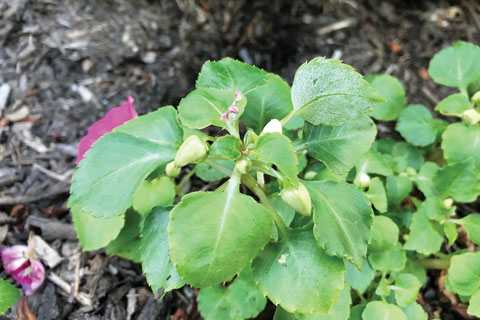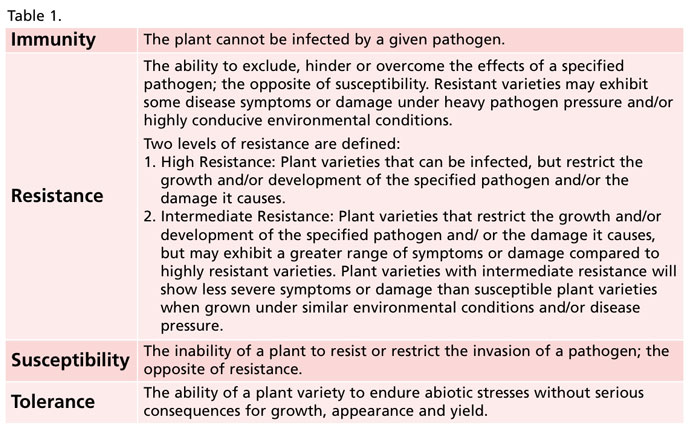7/1/2021
Plant Disease Resistance, Revisited
Dr. Nora Catlin

Originally published in the March 2021 e-Gro Alert newsletter.
There’s been a lot of recent discussion about disease-resistant plants, particularly about those for devastating diseases such as Impatiens Downy Mildew and Basil Downy Mildew. Resistant plants, however, aren’t new in concept nor practice. Over the years, we’ve seen many cultivars or varieties of different plants, ornamental and vegetable, with resistance to powdery mildews, rusts, leaf spots and many other diseases. Just take a close look at your seed packets or
catalogs.
Pictured: Impatiens Downy Mildew symptoms on the underside of an impatiens leaf. Photo courtesy of Margery Daughtrey, Long Island Horticultural Research & Extension Center, Cornell University.
When plant resistance is talked about, you’ll hear the terms “resistance,” “immunity,” “tolerance” and “susceptibility” … but what does each of those terms really mean? What about “high resistance” or “intermediate resistance”?
AmericanHort recently published a white paper, “The Use of a Standardized Set of Terms to Describe Plant Disease Resistance in Environmental Horticulture,” to address these questions and to provide guidance for the labels used. The definitions (Table 1) described by AmericanHort align with the definitions used by the International Seed Federation (ISF) and the American Seed Trade Association (ASTA). You can access the full white paper at hriresearch.org/americanhort-hri-recommend-terms-for-disease-resistance-claims.
This isn’t just a vocabulary lesson—there are a few pieces of information contained within those definitions that, as a greenhouse plant producer, you should take note of. First, resistant does not mean immune. Immune plants cannot become infected by a given pathogen. Resistant cultivars can become infected by the pathogen, but they’ll be less affected than a susceptible cultivar.
 Also, note that not all resistance is created equal—some will be considered highly resistant and some intermediate. Another important concept to be aware of is that new strains (or biotypes, pathotypes or races) of a pathogen can emerge, and that a resistant cultivar may not remain resistant to the newly emerged pathogen strains.
Also, note that not all resistance is created equal—some will be considered highly resistant and some intermediate. Another important concept to be aware of is that new strains (or biotypes, pathotypes or races) of a pathogen can emerge, and that a resistant cultivar may not remain resistant to the newly emerged pathogen strains.
What does this mean to you as a grower? Don’t assume that you’re free from worrying about losses from troubling diseases, or free from the need to scout or be watchful for those diseases, if you’re growing resistant varieties (even highly resistant ones), especially when environmental conditions are favorable for the disease.
When available, resistant plants can be a very useful addition to the management strategies you use in your greenhouse (and may also help with garden performance and consumer satisfaction). But remember that resistant plants are just one tool in your toolbox and you should continue to use a multi-faceted approach to disease management, including other tools such as good IPM practices like sanitation, scouting and being prepared to supplement with appropriate management products as necessary.
Lastly, remember that for any cultivar that’s advertised to have disease resistance, the resistance is specific to a particular pathogen, not all or many. Ideally the cultivar will be labeled as such—for example, “downy mildew resistant” instead of “disease resistant.” If labels are unclear and you’re uncertain which specific disease the cultivar is resistant to, ask your plant supplier. GT
Dr. Nora Catlin is a Floriculture Specialist for the Cornell Cooperative Extension, Suffolk County.